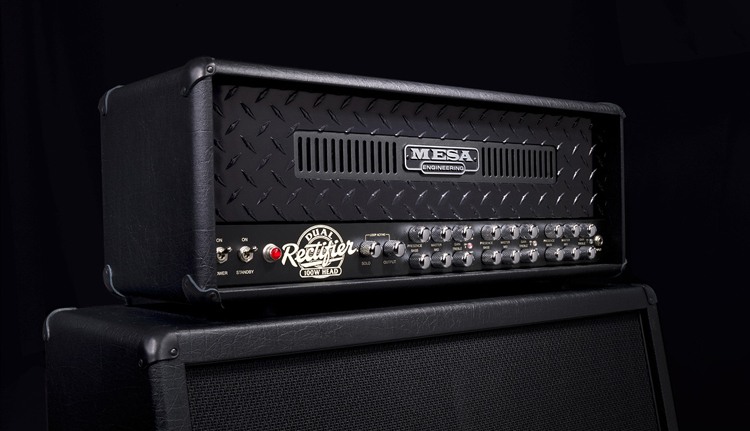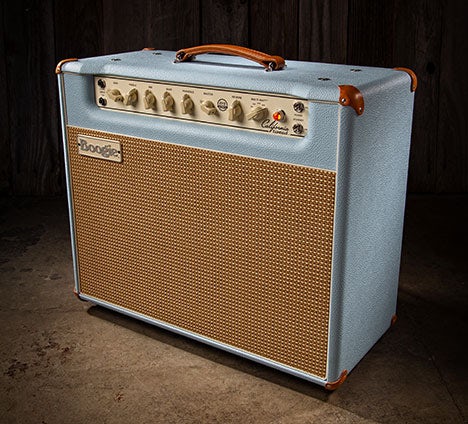Amplitudes: The Mesa Boogie Blog
History
Mesa® Employee Spotlight: John Marshall and
the evolution of the Recto reign ~ Part 2

Mesa Employee Spotlight and Round table discussion:
John Marshall ~ Circuit Ambassador of the NEW Dual and Triple
Rectifiers and discussion with Director of R & D,
Doug West and Director of Sales, Steve Mueller.
(Part 2 of a 2 part interview)
Amplitudes: It’s good to know that the greatness of the original Rectifiers are so fiercely protected and referenced. We've talked about the things that haven't changed. Can we talk about the things that have changed?
John: Well – one of the new things in this Recto that brings the best of all the Recto versions into one has to do with the Presence controls. On the original 2 channel Rectos, the Orange channel had a presence pot value that was selected based on its sweet spot for use in Vintage high gain. The Red Channel (channel 2) used a different Presence control specifically chosen for use in the Modern high gain mode.

When the first 3 channel amps were released, the 2nd channel, by default, used the Orange Channel presence pot value (from 2 channel versions) and the 3rd Channel used the Modern channel presence value. In this new version, when you switch between the Vintage and Modern modes in either Channel 2 or 3, the historically appropriate value and taper of presence pot is switched into the circuit. We were able to make both channels optimized for whatever mode you’re in.
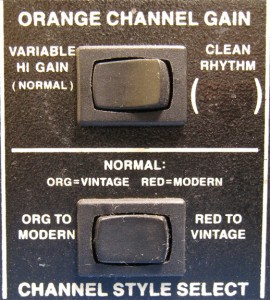
Steve: It took the concept of Channel Cloning from the original 2 channel amps and made it better! And I’d like to mention that the idea of incorporating the switchable presence option stemmed from the evolution and design of the Stage I Stiletto and perfected in the Electra Dyne which led to the use of a similar layout in the new Rectos.
Doug: With the new Recto’s Presence controls, the player now gets to decide how they want to configure the true, original high gain modes. If you want 2 channels of the identical mode with maybe a volume difference or gain enhancement or something similar the new layout provides for that. It really is Channel Cloning in its truest form.
Steve: And people should find a much better balance and taper of the Presence controls between Vintage and Modern modes on the new Rectifiers. Also, while the signature characteristics of this amp are generally centered around Vintage and Modern gain channels and sounds, what’s been done on Channel 1 has taken us to places that we’ve never gone before on Dual and Triple Rectifiers.
John: That’s one of the places I wanted to go with this as well. Features like the Series Loop and the improved Clean modes are things that Randy had already improved on in previous models like the Roadster and Road King and they were ultimately refined even more in the Mark V design process. The lineage for these clean sounds goes back to the Lonestar, and now elements of this are incorporated into the new Recto. It also led to some refinements to the Pushed mode that makes it even more versatile.
Doug: Its also worth pointing out that in the new clean channel of the Rectos – just like the circuits in the Roadster and Road King – signal is routed through an input preamp stage that is optimized for clean sounds. But when you are in channels 2 and 3, the input stage is switched and configured to stay true to the original input stages used throughout the high gain modes of the Rectifiers.
And this brings up what I consider to be one of the most important points of all. None of these improvements would happen if it wasn't for the constant evolution going on all the time at Mesa. The new Rectifier benefited from the Mark V and the Electra Dyne before it and even further down the line. Everything we learn goes into the next product we're working on. I think this is what separates Mesa from other companies. We have these widely different amplifiers, circuits and sounds we’re known for, but throughout, there's the common thread of features, reliability and versatility that encompasses the evolution of Mesa.
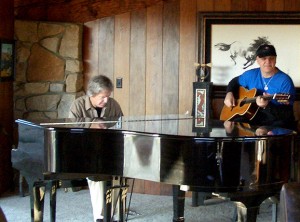
Steve: And this also reflects the fact that Randy is more of a consummate musician rather than just being a guitarist. He's chameleon-like and open enough to allow for the huge variety of tones that we seek out in the products. Over the years of doing this, the standard that Mesa has always held itself to and its own accountability is growing by the year. The Dual Rectifier is an amazing example of a complete deviation from anything else that anybody, anywhere, had ever done. It created a phenomenon and
you really can't say that about very many products.
Doug: Well - you could say it about the Mark I...
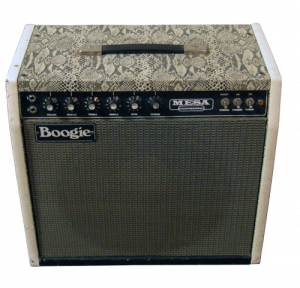 Steve: You're right! And how many companies have successfully re-invented themselves in two completely different ways. This could be an interview by itself but it’s evidence to the excellence of the design team. The designer is not hung up on his own stylistic preferences.
Steve: You're right! And how many companies have successfully re-invented themselves in two completely different ways. This could be an interview by itself but it’s evidence to the excellence of the design team. The designer is not hung up on his own stylistic preferences.
Doug: Randy is amazing at taking insights from ALL guitar players and that’s one of the reasons the team is so strong.
John: I'd also throw in that another aspect of Mesa evolution is the way Randy and Jim have run the place and how many guitar players here bring their input, ideas and styles to the table in the design process now. Doug has for three decades already and you, Steve, bring a tremendous amount of this to the table and have for years as well. Marcus, Mikey T and Kris from customer service, Tim from Artist Relations – there’s a wide variety of playing styles and likes and dislikes that all help shape and reference the final product now and Randy is so open to all the input, even - or especially - when people disagree.
Doug: And he also let's everyone grow to their potential which is one of the coolest things for all of us here over all these years.
John: And what you said also goes out to Jim just as much. That guy just planted me in a pot here and fed and watered me everyday and let me grow to this and I can't thank him and Randy enough for that. As I improve my skills it allows me to be more deeply involved and Randy shares more and more of his knowledge with me. I try not to get gobsmacked by it but sometimes its like getting guitar lessons from Jimi Hendrix or something. And not even lessons so much, but more like hanging out and jamming with Hendrix… or Jeff Beck or some other huge guitar great. And it’s that way because Randy is so cool about all of it.
Doug: That’s truly amazing, John. I’m increasingly blown away by how thoroughly Randy is committed to not only what has been his life's work and passion but also furthering and passing on that excellence to the next generation. This is one of the places where he's different that a lot of bosses who just want to cash out and go hang out on a golf course...
Steve: I know I speak for all of us when I say how lucky we all feel to be working in such an amazing family environment like Boogie.
Amplitudes: Can you guys expand on the Multi-watt feature on the amp and how it relates to the new Recto's or affects them differently from other models we've used them on? And how to get the most from them…
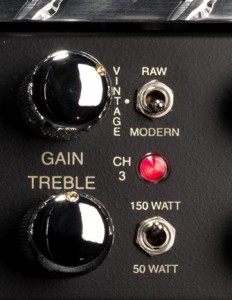
John: Of the list of things that got brought to the concept of the project, the addition of Multi-Watt was the first thing on the list - almost a catalyst for the project. Given the advancement of the Road King’s Multi-wattage and multi-tube compliment options and the introduction of the Roadsters, it was long overdue but the process is never completed overnight and it takes time to get that and everything else right along the way.
Doug: The best thing about the Multi-watt feature is that it opens the amp up to way more than just heavy rock sounds. When you add the 50 watt and the ability to select that on any channel you can really start to use the power section and its threshold for distortion as part of the tone and start reducing the amount of gain you use on the front end. And for people who don't really need the amp for metal sounds, lower wattages opens up the spectrum for clip-ability for a huge variety of classic medium preamp gain sounds that use power section clip to finish them off.
Steve: I think it’s important to note that Multi-Watt is a patented feature. Just thinking about the original concept of improving something like the Rectifiers is kind of scary because of the kinds of preconceived notions people tend to have about "New and Improved". That’s why it takes a lot of time to not only bring these things to fruition but even to consider them and even just structure the concepts behind them. That original conversation and concept was about bringing the features that had become so popular on so many of the other models starting with the Road King as the amp that began the multi- wattage idea through its sister patent, Progressive Linkage. From there, we had to include the Channel Assignable Rectification or Recto Tracking as we like to abbreviate it. That had to be included as it was born from the Road King's and Roadsters as well. And finally, making the evolution, ironically back to, the series loop. Aside from our own inclinations to want to do this stuff, customers were asking for it! And beyond the basic concepts for improvement, the other element that brought this to the table, Doug said best: “yeah - it's an icon, but what can we do to raise the bar”? That’s what drives us this far and even beyond.
John: One of the things we haven't covered yet here is the Raw mode. In the process of the board layouts and working with you, Doug, we struggled for a good while getting the Raw mode to the place where it was before in the previous 3 channels. One day, just when we were about 99.2% there, Randy walked in sight unseen and in about 30 seconds said, "well, what about this"? Bang - there it was! We wrangled with it for weeks and then Randy walked in and it was done.
Doug: That points again to Randy being so open. There's been plenty of times when Randy's been stuck on something and someone else, or you, John, walks in and has a look at where things are at and suggests something from a previous model that will move things forward. When you've been working on something for so long, sometimes it takes the perspective of someone who isn't so deeply involved or who hasn't been so completely absorbed by one little detail to provide the leg up for the breakthrough and . I've seen you do that for Randy, John. It’s that same old thing – when you are that deep in the forest, it’s hard to see the tree tops.
Amplitudes: Any closing statements gentlemen?
Doug: I'd just like to say thank you for all of those customers out there who have heard tone the same way we have for all these years now. We all feel blessed to be able to serve them and to create something they appreciate and have it be something we love to do.
Steve: And I would just like to encourage everyone out there that plays guitar to go find one of these new Duals or Triples to plug into because, you know...truth in advertising is an interesting thing to say these days because there doesn't seem to be much of it... but in our case, its the hallmark here - integrity! When we say this is the best sounding, best feeling and most versatile Rectifier we've ever offered, I'd rather people just go out and experience one for themselves and hopefully this article can inspire them to do so. I know that once they do and they compare it to anything else, we won't have to say anything. Their ears and their hands will tell them everything they need to know!
John: And while that’s a great one to end on, I'd like to add that… I think you ain't seen nothin' yet!
